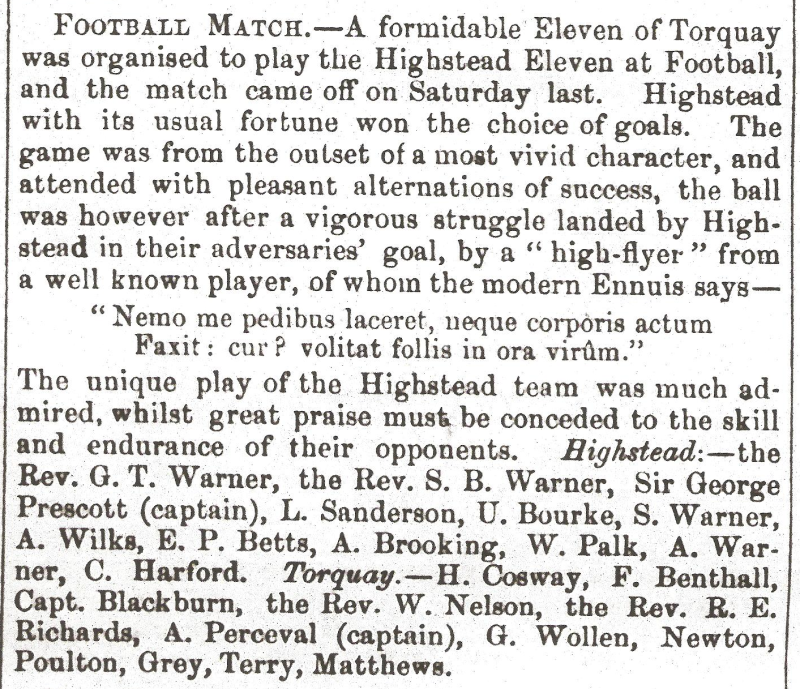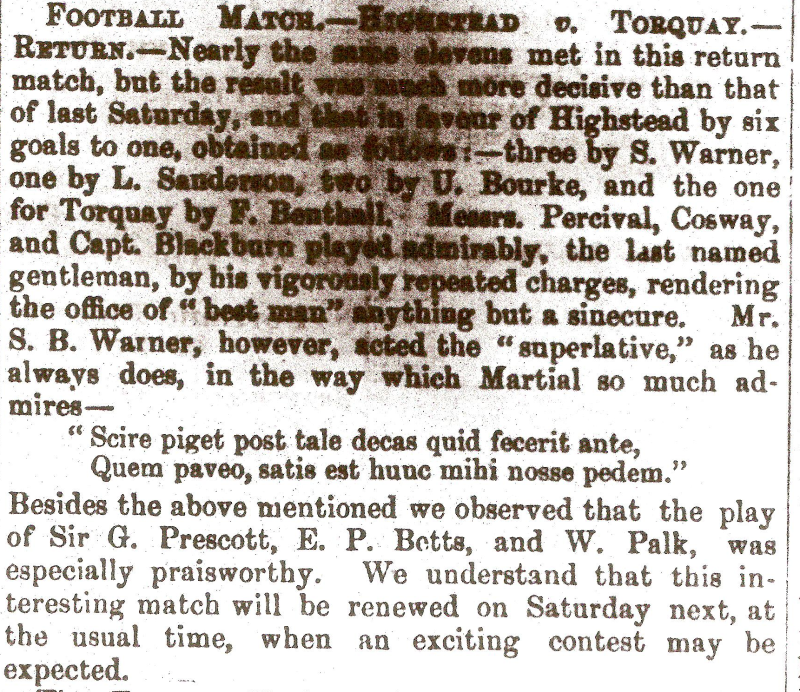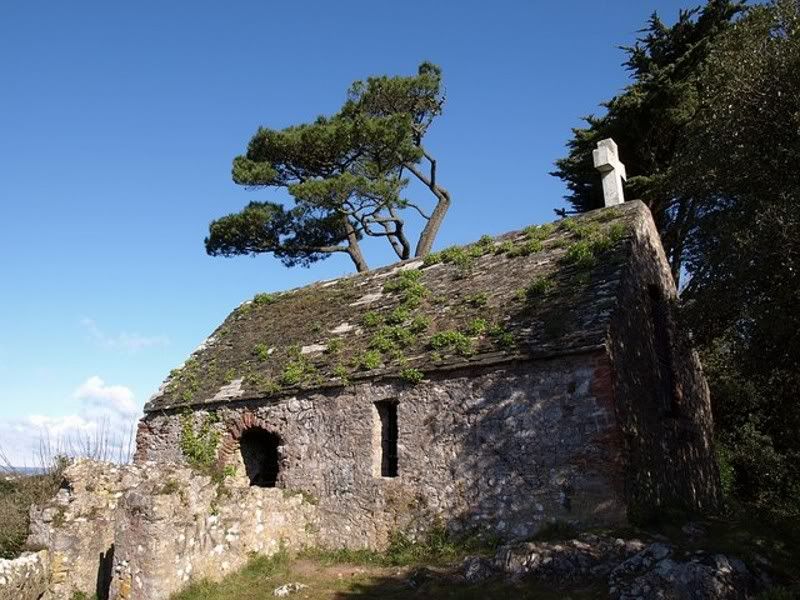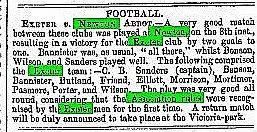Jon
Admin 
Posts: 6,912
|
Post by Jon on Jan 1, 2011 10:58:51 GMT
Torquay Directory 19/2/1862:  19/11/1862  26/11/1862  3/12/1862  10/12/1862  17/12/1862  31/12/1862  |
|
Jon
Admin 
Posts: 6,912
|
Post by Jon on Jan 2, 2011 0:41:20 GMT
|
|
Deleted
Deleted Member
Posts: 0
|
Post by Deleted on Jan 2, 2011 10:44:48 GMT
I quickly looked at Jon's posting when I got back from Hereford and he's taken much of the wind from my sails with his midnight posting (especially the point about these reports just pre-dating the foundation of the Football Association).
Highstead was, indeed, a private school on Bronshill Road and there is still a building of that name on the townward side of the road towards the St Marychurch Road end. I would imagine the school of the 1860s was a by-product of a booming town that had been connected to the railway system (at Torre) since the late 1840s. A school, perhaps, for the local ascendency to send their offspring (there’s a Palk in the team) and for wealthy folk in London and the Home Counties to pack the boys on to the train at Paddington if Eton or Harrow wasn’t an option? Remember that, at the time, Torquay was becoming “known” to society now its’ population (together with Cockington and St Marychurch) had reached 20,000. It was no longer a quaint little fishing quay unable to support a Harrovian rules team. It was "in".
And what of the Harrow link? The name which interests me is E P Betts – could he be related to Morton Peto Betts, Harrow School, Wanderers and England; scorer – under the pseudonym of “A.H.Chequer” (a Harrow Chequer) of the very first FA Cup-winning goal in 1872?
Sir George Prescott might have been the youthful 4th Baronet Prescott of Theobald's Park who would have been around fifteen or sixteen at the time. You can imagine the social order dictated he should be captain.
The Chapel Hill ground, the Royal Gymnasium and Bentley's cricket depot - what do we know of these sporting venues of one hundred and fifty years ago?
|
|
rjdgull
TFF member
 Admin
Admin
Posts: 12,231 
|
Post by rjdgull on Jan 2, 2011 11:01:21 GMT
Would the chapel hill ground have been the Cricketfield Road pitch?
|
|
Dave
TFF member

Posts: 13,081
|
Post by Dave on Jan 2, 2011 12:40:37 GMT
Would the chapel hill ground have been the Cricketfield Road pitch? I would think that was more likely the case Rob as providing the pitch was there then, where else in Torquay could it be? Was cricket being played before football? if so then there is a good chance it was being played around that time at Cricketfield road. The fact that is the name of the road might suggest cricket was only once played there. A really great find Jon and so interesting to read, I would love to see many old newspaper reports from the past appear in our history room. St Michael's Chapel on Chapel hill is still there only in ruins, I find it strange I have never gone and taken a look at it myself. I will now take a look in the very near future.  |
|
Deleted
Deleted Member
Posts: 0
|
Post by Deleted on Jan 2, 2011 13:17:28 GMT
St Michael's Chapel on Chapel hill is still there only in ruins The ruined nature of the chapel adds to the appeal. Worth a look! I'd wondered about Cricketfield Road or whether there is any other land around there that is reasonably level. Both the Briwere Road and Torre primary school areas are pretty precipitous. What about the space now used by the reservoir at the top of St Michael's Road? Remember the railway line at the foot of Chapel Hill would have been in place by 1862. |
|
Jon
Admin 
Posts: 6,912
|
Post by Jon on Jan 2, 2011 14:21:46 GMT
Chapel Hill (more commonly called Chapel Hill Cross) was indeed the cricket ground currently used by Barton CC, but which was the home of Torquay CC until they moved to the Rec in 1926. Torquay CC was founded in 1851 and they played for one season at Windmill Hill before moving to Chapel Cross in 1852. There is mention of football played there as early as 1856 - see this cutting from Trewmans dated 6 March 1856. I wonder if this was the Harrow boys?  Bentley was the cricket professional-cum-groundsman at Torquay CC, so I guess that "Bentley's cricket depot" might mean the club pavilion. I shall have to dig out my copy of Ray Batten's brilliantly-researched history of Torquay CC (with a foreword from Justin's dad) to see what other cross-references I can find. |
|
Jon
Admin 
Posts: 6,912
|
Post by Jon on Jan 3, 2011 10:15:33 GMT
|
|
Jon
Admin 
Posts: 6,912
|
Post by Jon on Jan 3, 2011 19:36:35 GMT
It is a fair bet that this is Morton's older brother Edward Peto Betts Case proved: libsysdigi.library.uiuc.edu/ilharvest/BrittleBooks_Open/Books2009-06/trinco0001admtri/trinco0001admtriv00005/trinco0001admtriv00005_ocr.txt TRINITY COLLEGE ADMISSIONS 269 Betts, Edward Peto. Son of Edward Ladd Betts. Born August 2, 1844, at Wateringbury, Kent. Pupil of Mr G. T. Warner, Highstead, Torquay, Devonshire. Pensioner, December 14,1863. Tutor, Mr Burn. [Matriculated, 1864; B.A. 1868; m.A. 1879.] |
|
Deleted
Deleted Member
Posts: 0
|
Post by Deleted on Jan 3, 2011 23:48:01 GMT
Young Lancelot Sanderson in that Highstead team became a man of the cloth and Harrow master himself. He also happened to marry old Warner’s daughter Katherine down at St Mary Magdelene in Upton.
The boy Palk was soon to go up to the Royal Military Academy in Woolwich.
It gets confusing with the Warners because there’s a George Townsend in each generation. One G.T.W (1841-1902) played cricket for Cambridge University and the MCC; another (his son 1865-1916) turned out for the Gentlemen of Devon and was the father of Sylvia Townsend Warner, the novelist and poet.
Highstead’s most famous product may have been John William Strutt, third Baron Rayleigh, the author of the Theory of Sound. Although he became an eminent scientist, Strutt was a sickly child and may have not been up to Harrovian rough stuff at Chapel Hill (and, besides, he would have been an old boy by 1862). However, he did encounter young Betts and wrote home to his mum about Bettsy having an eye problem (something about the crystalline lens being removed?).
Apparently there's a 1864-65 Highstead team picture in a book called Victorian Dress in Photographs by Madeleine Ginsburg in which "the lads wear youthful but fashionable clothes, low-crowned bowlers with loose, hip-length, high-buttoning jackets and wide cut trousers"
Marvellous stuff, this Google Books innovation!
|
|
Deleted
Deleted Member
Posts: 0
|
Post by Deleted on Jan 4, 2011 20:17:05 GMT
Digging deeper into the tale of the George Townsend Warners, it becomes apparent that the first we encounter taught at Harrow between 1846 and 1853. He’s the chap who took over Highstead. The next in succession, born 1841, followed in his father’s footsteps by teaching at Highstead before becoming head of Newton College – on College Road on Wolborough Hill - in the mid 1870s. A history of Newton Abbot, published in 1903, mentions that rugby and squash racquets were the big sports at Newton College. However, it also refers to the part the college played in the formation of the town’s first association club in 1888. There’s a 1915 picture of Newton College at www.francisfrith.com/newton-abbot/photos/newton-college-1915_67716/Reading about the frailty of some of Highstead’s pupils, I did wonder if Torquay might have been deemed appropriate for weaker boys unsuited to a 19th century public school life which often bordered on the barbaric. This theory is strengthened by an 1878 advert for the Rev WB Davis’s school at Apsley House: “Torquay as a Place of Education for delicate boys: We feel sure that many parents would do well to consider Torquay for boys who are not strong enough for Public School life but who, in all probability, may become fairly strong men by judicious treatment in such a climate.” Ah! Might this explain why Harrow football in South Devon wasn’t quite strong enough to become an early force in the land? And has our football been hampered ever since? I did some of this research today in the Westcountry Studies Library in Exeter where they had a copy of a 1910/1911 directory of Torquay to which, I think, Jon has previously referred. There was also A New Look at Old Newton Abbot written by Harry Unsworth and published in 1993 by a certain Mike Bateson of Haccombe Farm, Coffinswell. A few other things I discovered today were that Torquay Cricket Club had an “American bowling alley”in Victorian times; both Dickens and Disraeli visited the town within a few months of that early match in 1862; and that there was a Torquay Errand Boys Association from 1870s onwards. Maybe they should have taken up the soccer mantle rather than the posh lads? With a bit of organisation, supported by commercial astuteness, surely they could have got us in to the Football League from Day One in 1888. |
|
Dave
TFF member

Posts: 13,081
|
Post by Dave on Jan 4, 2011 20:43:53 GMT
Fascinating stuff to read Nick and it must be great fun doing the research as I'm sure that is something you really enjoy doing.
|
|
Jon
Admin 
Posts: 6,912
|
Post by Jon on Jan 4, 2011 23:07:47 GMT
A little more on the three GTWs taken from: www.archive.org/stream/p2alumnicantabri06univuoft/p2alumnicantabri06univuoft_djvu.txtWARNER, GEORGE TOWNSEND. Adm. pens, at Trinity,
Feb. 4, 1833. S. of John. B. Jan. 8, 1815. [School, Christ's
Hospital.] Matric. Michs. 1833; B.A. 1839; m.A. 1844. Ord.
deacon, 1838; priest, 1839. C. of St Paul's, Leeds, -1841.
Minister at Trinity Church, Swansea, 1844-6. Assistant
Master at Harrow, 1846-53. Died Feb. 14, 1869. Father of
William S. O. (1864) and the next. (Christ's Hospital
Exhibitioners; Crockford; Clergy List.)
WARNER, GEORGE TOWNSEND. Adm. pens, at Trinity,
Oct. 17, 1859. S. of the Rev. George Townsend (above), of
Torquay. B. Mav 9, 1841, at Southampton. School, Harrow.
Matric. ' Michs. i860; B.A. 1864; m.A. 1868. Ord. deacon
(Exeter) 1864; priest (Salisbury) 1866; C. of St Mary-
Magdalene, Torquay, 1864-7. C. of Stoke Gabriel, 1867-75.
Head Master of Newton College, Newton Abbot, 1875-95. R.
of Alfold, Surrey, 1895-1902. Married — , dau. of G. Moir.
Sir Arthur Quiller-Couch, one of his pupils, left this descrip-
tion of him: 'A tall sanguine man, in the middle years, but
athletic yet, a rare runner between wickets; in school, and
out of it, an organiser: a gentleman with every attribute of
a good Head Master save a sense of justice, of which he had
scarcely a glimmer, and being choleric, could be angriest
when most unjust.' Died Nov. 22, 1902, at Torquay. Father
of George (1884, sub Townsend-Warner) ; brother of William
S. O. (1864). (Crockford; Quiller-Couch, Memories and
Opinions; The Times, Nov. 25, 1902.)
TOWNSEND-WARNER, GEORGE. Adm. pens, (age 18) at
Jesus, Oct. 1884. [Elder] s. of the Rev. G[eorge] Townsend
(1859, sub Warner) [sometime Head Master of Newton
College, Devon]. B. [Mar. 31, 1865], at Torquay. School,
Harrow. Matric. Michs. 1884; B.A. (Hist. Trip., ist Class)
1887; Lightfoot Scholar, 1888; WheweU Scholar, 1889; m.A.
1891. Fellow, 1890. Assistant Master at Harrow, 1891-1916
(House Master, 1904). Author, Landmarks of English In-
dustrial History. Joint Editor of Harrow School, and Editor
of the Record of the Harrow Association. Died Sept. 23, 1916,
at Harrow. {Harrow Sch. Reg.; The Times, Sept. 25, 1916.) As Barty mentions, Newton College was a big Rugby school and GTW2 completed his conversion to the dark side by becoming Chairman and President of Devon Rugby Football Union. I'm not sure about the first Newton association club being formed in 1888 - see this cutting from Trewmans 19 November 1873:  It wouldn't surprise me that frail or sickly boys were dispatched to Torquay for schooling as the town built its reputation on its healthy climate. Ray Batten's book gives chapter and verse on the bowling alley. The original tender for the pavilion extension in 1864 was to include gas lighting, an "American type bowling alley" and stables. There was heated argument at the 1865 AGM because the bowling alley had not been fitted and would cost an extra £130. The total cost of the work ended up at over £800. |
|
Deleted
Deleted Member
Posts: 0
|
Post by Deleted on Jan 5, 2011 10:01:06 GMT
Sir Arthur Quiller-Couch, one of his pupils, left this description of him: 'A tall sanguine man, in the middle years, but athletic yet, a rare runner between wickets; in school, and out of it, an organiser: a gentleman with every attribute of a good Head Master save a sense of justice, of which he had scarcely a glimmer, and being choleric, could be angriest when most unjust.' Quiller-Couch - "Q" - Cornish-born writer; Oxford Book Of English Verse 1250–1900 and all that. Commemorated in Fowey; he's even said to have been the inspiration for the character of Ratty in The Wind and the Willows. But was he a Newton Abbot footballer? Deducing the tale from various sources, I suspect GWT2 took over Highstead on his father’s death in 1869 (subsequently moonlighting whilst serving the parish of Stoke Gabriel). He then moved to Newton in 1875 taking, according to one of the histories, thirteen boys with him to revive the fortunes of the Newton Abbot establishment. |
|
rjdgull
TFF member
 Admin
Admin
Posts: 12,231 
|
Post by rjdgull on Jan 6, 2011 13:21:13 GMT
There is a quaint picture of the chapel hill old pavilion near the back of the Herald Express today which may be of interest. I can't scan in it though.  |
|